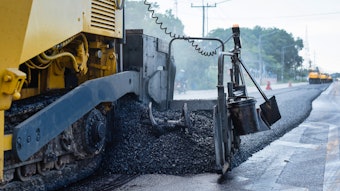
What do you do with approximately seven centerline miles of rural county roads constructed of aging Portland cement concrete? Well, you could remove the six-inch structure and start over, or you could rubblize it and top it with a hot mix asphalt overlay, or you could "crack and seat" the old concrete and then top it with six inches of HMA. That's exactly the option Davenport, IA-based McCarthy Improvement Co. executed earlier this year on two rural roads in Scott County's "farm-to-market" system.
The solution proved advantageous to both the road agency and the contractor. Scott County not only wanted to avoid the high cost of removing the old concrete, but also wanted to widen the original 22-foot-wide structure and add some structural depth in the process. For the contractor, the approach facilitated a quicker turnaround by leaving the concrete in place and it also provided a good base structure for the new HMA overlay.
The difference in a "crack and seat" versus rubblization method is that the crack and seat method only creates hairline fractures in the concrete, to make the rigid slabs more flexible; whereas rubblization pulverizes the concrete into large chucks of concrete that can be compacted similar to a large stone base. In a crack and seat operation, once the hairline fractures have been established throughout the concrete structure, a 50-ton roller is then used to seat the flexible concrete structure. Antigo Construction of Antigo, WI performed the crack and seat portion of the project.
HMA placement
With base preparation completed, McCarthy was able to immediately begin placing the approximate 40,000 tons of HMA required in the three lifts that make up the 6-inch overlay. A 3-inch base course with ¾-inch stone was applied over the concrete, followed by a 1.5-inch with ½-inch stone intermediate course then a 1.5-inch with ½-inch stone wearing course.
McCarthy used a Blaw-Knox 5510 to place the mats, which were then compacted with a Caterpillar breakdown roller, a Bomag pneumatic roller and a Hypac finish roller.
"It was a pretty straight forward project," notes Jim Rezac, asphalt operations manager for McCarthy. "We did run into a few soft spots that required a full-depth patch reconstruction before the final HMA mats could be placed."
All three lifts were constructed to meet the Superpave design standard Iowa DOT specifies for road projects. Mix designs required a performance graded asphalt binder of PG 58-28 at six percent content of the total HMA quantity. Compaction density was set at 150 pounds per square foot.
McCarthy has been a heavy highway contractor for over 100 years, specializing in both concrete and asphalt paving. The company has worked on projects around the country, including roads, runways and other large surface structures. Today, McCarthy Improvement Co. focuses on airports and interstates in the Midwest, Southeast and Southwest, as well as commercial paving projects in the Quad Cities and surrounding area. The company maintains a complete quality testing facility for both concrete and asphalt, providing QC/QA lab certification for projects in Iowa and Illinois.


























